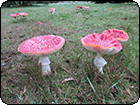Did anyone see this MeTa thread about an old post? It's FPP from 2002, about an article in a Miami paper about a complicated set of myths created by homeless children, dealing with good and evil and hope and love and how to stay strong in a cruel and heartless world.
→[More:]
The damn thing made me cry; you might not want to read it at work for that reason.
 photo by splunge
photo by splunge
 photo by TheophileEscargot
photo by TheophileEscargot
 photo by Kronos_to_Earth
photo by Kronos_to_Earth
 photo by ethylene
photo by ethylene